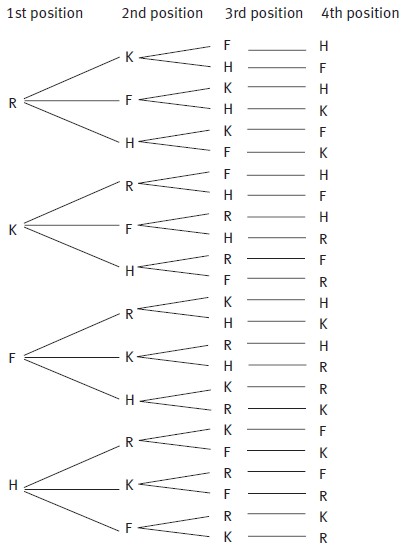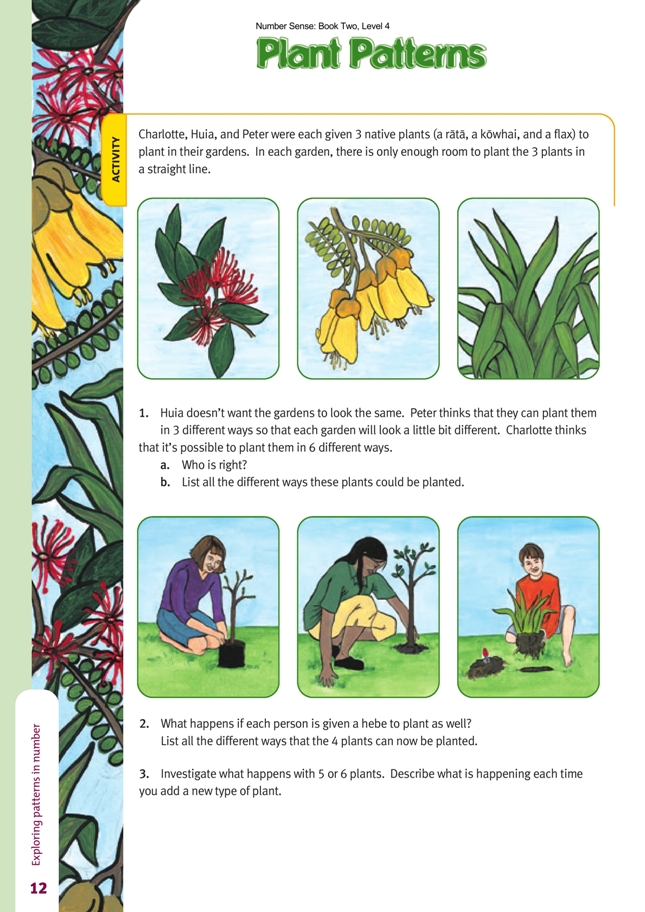This is a level 4 problem solving activity from the Figure It Out series.
A PDF of the student activity is included.
Click on the image to enlarge it. Click again to close. Download PDF (714 KB)
explore patterns in number.
This activity could be used to help students:
- learn about sample space, that is, the number of arrangements or possible outcomes
- develop an understanding of factorials; for example, 3! (read this as “3 factorial”) is 3 x 2 x 1 = 6.
Activity
The mathematical ideas underlying this activity are those of sample space and factorials. It may be a good idea to begin with just two different plants and invite the students to show how many different ways they can be arranged (that is, two ways). Then move on to the three plants in the activity. Different strategies can be used to work out the number of possible arrangements, including drawings, names, and letters (see the Answers). The students can be encouraged to use a systematic approach to make the task more manageable and to ensure that they do not repeat arrangements or leave some out. They should be able to work out that, with three different plants, six different arrangements are possible. They can share their strategies with the rest of the class.
If they use a similar approach with question 2, they will eventually find that there are 24 possible arrangements, although at this point, the increased number of plants makes the task of finding possible arrangements rather challenging. Discussion could be useful at this point to clarify what is happening. Essentially, there are four plants the students can choose for the first position in the garden, three for the second place, two for the third place, and whichever is left over for the fourth place, so there are 4 x 3 x 2 x 1 = 24 possible arrangements.
A tree diagram may help to make this clear:
To go further, the students need to find the underlying pattern for the number of arrangements. Constructing a table of what they know already may help because listing arrangements or constructing tree diagrams will prove to be very time consuming. For example:
| Number of plants | Number of possible arrangements |
| 1 | 1 |
| 2 | 2 |
| 3 | 6 |
| 4 | 24 |
At this point, some of the more astute students may be able to see that the number of possible arrangements for a given number of plants is that number of plants multiplied by all the previous numbers of plants. Thus, for four plants, the number of possible arrangements is 4 x 3 x 2 x 1 for the reasons discussed above.
What the students may not yet know is that such numbers are called “factorials” (also mentioned in the notes for page 5 of the student book and see also page 4 of Number: Book Five, Figure It Out, Years 7–8, and the notes for this page). If the students are able to recognise this pattern, they have effectively solved the last part of question 3 and can apply this to the case of five or six plants.
The students will now probably be able to work out that the number of possible arrangements for five plants is 120 (that is, 5! or 5 x 4 x 3 x 2 x 1) and that for six plants, it is 720 (that is 6!, which is easily found by multiplying the result for five plants by 6).
Ask students who are having difficulty with five plants to consider the four-plant case and add another plant, say a mānuka, M. Tell them to take any arrangement of the four plants, say FKRH, and ask them how many positions they could place the mānuka in (assuming that the plants must still be in a straight line). The students should recognise that there are five possible positions for the mānuka in this arrangement, namely•F•K•R•H•, or MFKRH, FMKRH, FKMRH, FKRMH, and FKRHM. This will be true for every arrangement of the four plants. There are 24 of these, so there must be 5 x 24 = 120 or 5! = 5 x 4 x 3 x 2 x 1 possible arrangements of five plants.
Answers
1. a. Charlotte is right. Peter is partly right. There are three choices of plant for the first position in the garden, but because there are then two choices of plant for the second position (and one for the third), there are actually 3 x 2 x 1 = 6 possible arrangements (as Charlotte suggested, and as isted in b).
b. RKF RFK KRF KFR FRK FKR. There are six possible arrangements, which can be written as 3! (3 factorial).
2. There are 24 different ways when a fourth plant is added: 1 x 2 x 3 x 4 = 24, which is 4!
The 24 different ways are:
RKFH KFHR FHRK HRKF
RKHF KFRH FHKR HRFK
RFKH KRFH FRKH HKFR
RFHK KRHF FRHK HKRF
RHFK KHFR FKRH HFKR
RHKF KHRF FKHR HFRK
3. Five plants is 5! or 120 different ways.
Six plants is 6! or 720 different ways.
When a new plant is added, you multiply the new total number of plants by the previous total number of different ways.
1 x 2 x 3 x 4 x 5 = 120
120 x 6 = 720 (1 x 2 x 3 x 4 x 5 x 6 = 720)
